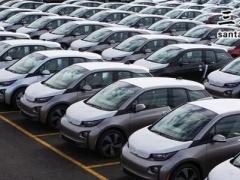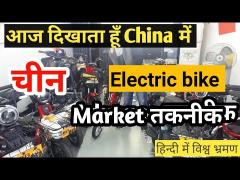印网友:中国为何能先于印度发展高铁
How could China develop high-speed trains ahead of India which had a larger railway network until th
How could China develop high-speed trains ahead of India which had a larger railway network until the '90s?
中国为何能先于印度发展高铁?上世纪90年代以前,印度铁路网还是比中国更大的
Quora评论翻译:
Manish Sharma, Living in Shenzhen, China since 2015. Have seen little bit of China.
Because we Indians don’t do something until its necessary or absolutely necessary.
We don’t show-off and spend money just like that.
I loves trains, I have traveled by trains in India (Rajdhani, Shatabdi, local, metro, sleeper, chair car, with ticket, without ticket). Indian trains are really optimized and utilized at great efficiency.
I have traveled by train in China as well, rather enjoyed it (G train also known as bullet train, K train, MagLev) , but recently it started to pinch my pocket. They are expensive, way expensive.
For comparision, what you pay in India and in China for around 1000 km journey.
270 INR -In India, just seat - 168 RMB in Chinese train, hard seat - which is 1623 INR
439 INR - Non-AC Sleeper - Chinese don’t have non ac sleeper, I have not seen so far.
1928 INR - Second AC Rajdhani- 333 RMB in Chinese train, sleeper with ac - which is 3208 INR. If you choose for softer bed in Chinese second AC, price will go 4912 INR.
(Chinese train doesn’t give food, Rajdhani does)
And in Chinese bullet train, price for 1000 km is (I checked for Ximen to Shanghai)
449 RMB in second class. (4325 INR) (Flight cost little more than this)
715 RMB in first class. (6887 INR)
1396 RMB in business class. (13447 INR)
Chinese has great train network, awesome bullet train network. Chinese has longer bullet train network than rest of the world combined. Pretty impressive.
But, in India, do we need bullet trains? I guess no, not yet. And not if they are this expensive. And Indian trains are running at great efficiency, I mean they run to their capacity. Chinese train, half empty most of the time.
Me with Maglev and Indian flag in Shanghai, which go till 431 km/hour (world’s fastest train train in regular commercial service). Easily any country’s pride (loved it). But for 30.5 km long track, spent 1.2 Billion USD, back in 2002, And 72 million USD in annual loss to operate it.
因为只有逼不得已的时候,我们印度人才会行动起来。我们不会为了炫耀而劳民伤财。
我喜欢坐火车,在印度坐过火车出行(特快列车、卧铺、坐票、无座的),印度的火车很多人坐。
我在中国也坐过火车,非常喜欢(G次列车也被称为子弹头列车,K次列车,磁悬浮),但最近中国火车的票价贵得让我开始感到拮据,太贵了。
对比一下,大约1000公里的旅行在印度和中国分别要花多少钱?
印度坐票270卢比,中国硬座168元,相当于1623卢比
印度非空调卧铺439卢比,中国没有非空调卧铺,到目前为止我还没见过。
印度特快空调2等舱1928卢比,中国空调卧铺333元,相当于3208卢比。如果选择中国的二等空调软卧,价格将达到4912卢比。
(中国火车不提供吃的,印度特快列车提供)
而中国高铁,1000公里的价格是(我查过西门站到上海的价格)
二等座449元(4325卢比)(机票价格仅略高于此)
头等座715元(6887卢比)
商务座1396元(13447卢比)
中国高铁特别发达。中国的高铁网络比世界其他国家加起来还要长,令人印象深刻。
在印度,我们需要高铁吗?如果票价这么贵的话,我认为不需要。印度火车运行效率很高,满负载运行,趟趟爆满。而中国的火车,大部分时间有一半是空的。
我和上海磁悬浮列车及印度国旗的合影,时速431公里(世界上最快的普通商业列车)。任何一个国家都会为之骄傲。他们于2002年投入12亿美元修了这条30.5公里长的磁悬浮,年运营亏损达7200万美元。
Visakh V Krishna, believes in the Indian growth story
The Short Answer: Strong will, Centralized Decision making, Beijing Olympics, Economy growth rate.
简言之:意愿强烈,集中决策,北京奥运会,经济增长率。
The Long answer:
详细说来,原因如下:
The Japanese built and inaugurated the Shinkansen right before the 1964 Tokyo Olympics.(Tokaido line).That was back in 1964. Fast forward to 2001, China was having the highest growth rate in the major economies and awarded to host the Beijing 2008 Olympics. Major sporting events like Olympics are ideal platforms to showcase your country's strength and influence (soft power). (Delhi got a serious improvement to its infrastructure before the 2010 Commonwealth games)
在1964年东京奥运会之前,日本人就建造并开通了新干线(东海道线)。到2001年,中国经济增长最快,获得了2008年北京奥运会的主办权。像奥运会这样的大型体育赛事是展示国家实力和影响力(软实力)的理想平台。(2010年英联邦运动会之前,德里的基础设施得到了大幅改善)
Between 2000 and 2012, China undertook a massive expansion of its high speed rail networks (Look at the graph). Today it leads the world with the largest high speed rail network with 16000 kms (built in almost a decade). The second biggest network is in Spain with 3100 kms. The sum total of high speed rail networks in all other countries is somewhere over 13000 kms. Still less than China.
从2000年到2012年,中国进行了高铁网络的大规模扩张(见图表)。如今,中国全贴全长16000公里(近十年建成),傲视全球。第二大高铁网络在西班牙,3100公里。其他所有国家的高铁网络总长超过13000公里,但还是低于中国。
source: UIUC RailTEC
来源:UIUC RailTEC
To add to this, they have a network of conventional long distance railway network (like in India) as well.
除此之外,中国普通铁路也不短
China has a long term plan with the travelling time from Beijing as the key focus. (Travel time circles as shown in the map below:)
中国有一个长期的计划。(旅行时距圈如下图所示:)
So, the plan is to keep building HSR networks until the travel time from Beijing to the farthest major city in the country is within 24 hours. In the mean time, these networks are only further going to stimulate the economy through the flow of goods and people. An ambitious plan of such a scale can be done in a short time only if you have:
1.The manpower to put into the project.
2.The demand for such a huge network.
3.The ability to acquire land and gain clearances with minimum delays.
4.The required technology.
5.A deadline in the immediate future. (atleast for the kick start)
中国将继续扩大高铁网络,构建北京到中国最远的大城市的旅行时间在24小时之内的网络。与此同时,高铁会加快商品和人员的流动,进一步刺激经济。只有具备以下条件,才能在短时间内完成如此规模的宏伟计划:
1.投入该项目的人力。
2.对高铁的需求。
3.能够在最短的时间征地
4.所需的技术。
Technology transfers in 4 levels catering different requirements:
(See the diagram with the timeline details)
source: UIUC RailTEC
4个层次的技术转移满足不同的需求:
(见图表和时间表细节)
来源:UIUC RailTEC
Before 1997, the Chinese railway system were no better than Indian Railways in anyway. The average speed of the trains were around 45 km/h. India was actually ahead with around 50 km/h with trains like Rajdhani and Shatabdi steadily maintaining 70-80 km/h.
在1997年之前,中国的铁路并不比印度铁路好多少。火车的平均时速约为每小时45公里。印度火车以每小时50公里左右的速度领先,像Rajdhani和Shatabdi这样的特快列车稳定保持每小时70-80公里的速度。
Over the time, China rigorously invested in High speed rail technology setting up research centres ,(Chinese Academy of Railway Sciences (CARS)) and State owned manufacturing companies over the time with the progress in technology transfer. Many of the models that run on the track are based on the initial car designs imported from companies like Bombardier and JLR.for e.g. (CRH1A & Bombardier Regina), (CRH2C and Shinkansen E2).
随着时间的推移,中国积极研发高铁技术,建立研究中心(中国铁道科学研究院)和国有企业,并在技术转让方面取得了进展。许多在轨道上运行的车型都是基于庞巴迪等公司引进的最初设计。例如(CRH1A和庞巴迪Regina), (CRH2C和新干线E2)。
Right now, China is undergoing the second boom of Highspeed rail network expansion:
目前,中国正在经历第二次高铁网扩张热潮:
High-speed rail in China
中国高铁
India's Railway system in the past two decades did not go through any major improvements on the scale as visible for China. In fact, Highspeed Rail System was one of the most discussed election promises by the new government in 2014. TheIndian Railways is burdened by a huge mountain of debt and FDI was recently announced for the sector by the current Railway minister to allow foreign firms.
过去20年里,印度铁路系统没有像中国那样取得重大进步。事实上,高铁系统是2014年新政府最受关注的竞选承诺之一。印度铁路背负着巨额债务,印度现任铁路部长最近宣布,允许外国公司投资印度铁路。
A dedicated research centre to study the feasibility for High Speed Rail in India was setup only in 2014 in IIT-KGP.
2014年,印度在印度理工大学卡拉格普尔分校建立了一个专门研究印度高铁可行性的研究中心。
The first time China started asking serious questions about the possibility of a highspeed rail network between Beijing and Shanghai, it was the 1990's. India is doing it for Delhi-Mumbai now in 2010's.
20世纪90年代,中国首次提出京沪高铁网络可行性,而印度直到2010年才为德里-孟买规划。
Instead of jumping directly to speeds above 350 km/h , it would be better to adopt the 4 stage plan as followed by China. This way, the dividends from increasing speeds will be realized more effectively and the money will be spent cautiously over the time period reasonably.
与其直接跨越到350公里/小时以上,不如采用中国所遵循的4阶段计划。这样,提高速度带来的红利就会更有效地实现,资金将这段时间内谨慎合理地使用。
Hopefully by 2030, we would have crossed 10000 kms of highspeed rail network. But for that to happen we should keep asking the right questions till that happens.
希望到2030年,我们可以建成10000公里的高铁网。但要做到这一点,我们应该找对问题,并提出解决方案。
Lup Ma, differentiating Thought
Most likely the answer for both cases is external politics. While India's internal politics do take more time due to its investment in the democratic process while China has taken the approach of the wise one knows best over the citizenry (ask Winston Churchill has been remarks about common folk); ultimately in both countries, things do get done.
这两种情况的答案很可能都是外部政治。由于印度在进程中的投资,印度的内部政治确实需要更多时间来处理,而中国采取了明智的做法,最了解公民的需求。最终,在这两个国家,事情都得到了解决。
Hotoun Tan, works at Nokia Networks Siemens
America was also a pioneer in developing rail transportation and yet doesn't have any high speed trains. All the initiatives to build HSR in America has failed (California) or are ending in failure (Texas) before it begins. Even existing low speed infrastructure is crumbling and somehow is not being fixed.
India is a robust democracy with a robust legal system just like America. It is too costly and difficult (compensation and legal disputes) to acquire land. Populist politicians can also hold up HSR development and incite opposition for various reasons.
美国也是发展轨道交通的先驱,却没有修高铁。所有在美国建造高铁的计划都以失败告终。即便是现有的低速铁路也在崩溃,而且不知何故没有得到修复。
印度是一个国家,拥有健全的法律体系,就像美国一样。(补偿和法律纠纷)征地成本太高、难度太大。民粹主义政客也可能因为各种原因阻碍高铁的发展并煽动反对。
Daniel Cohort, Big Data Director in China
China could mobilize much more social resources than India could in a very brief time. This means, once the government goal is set to be economic development, China can grow faster than India when other conditions are equal. High-speed rail is just one example of how China emphasizes the importance of good infrastructures.
中国可以在很短的时间内调动比印度多得多的社会资源。这意味着,一旦政府的目标设定为经济发展,在其他条件相同的情况下,中国可以比印度增长得更快。高铁只是中国重视基础设施重要性的一个例子。
Mohammed Kalam, works at India
China's forte is planning, determination, perseverance and implementation.
It shows in its industries where it can manufacture a huge range of cell phones, from the iPhone to a cheap budget phone. It shows in its arms industry, where it manufactures many aircrafts, fighters, albeit copies of Russian ones, its own tanks, vehicles, and missiles.
So the same is demonstrated in its high speed rail network.
中国的长处是计划、决心、毅力和执行力。
从iPhone到廉价的经济型手机,中国生产出了大量手机。展示了自己的武器工业,制造了很多飞机,战斗机,尽管是俄国飞机的复制品,中国建造了自己的坦克,车辆和导弹。
高铁网络也证明了这一点。
Aditya Sagar, studied at Blinn College
Short answer-loyality towards country
简言之:忠于国家的利益
Anonymous
Chinese railway in early 1990s was built by Chinese. Indian railway in early 1990s was built by British.
中国铁路是在20世纪90年代初由中国人修建的。而印度铁路是在20世纪90年代初由英国人修建的。
外文:https://www.quora.com/How-could-China-develop-high-speed-trains-ahead-of-India-which-had-a-larger-railway-network-until-the-90s
版权声明
我们致力于传递世界各地老百姓最真实、最直接、最详尽的对中国的看法
【版权与免责声明】如发现内容存在版权问题,烦请提供相关信息发邮件,
我们将及时沟通与处理。本站内容除非来源注明五毛网,否则均为网友转载,涉及言论、版权与本站无关。
本文仅代表作者观点,不代表本站立场。
本文来自网络,如有侵权及时联系本网站。
阅读:
-
1
चाइना में रेडी और ठेले Local shops in china || L...
- 2
- 3
- 4
- 5
- 6
- 7
- 8
- 9
- 10
-
1
चाइना में रेडी और ठेले Local shops in china || L...
- 2
- 3
- 4
- 5
- 6
- 7
- 8
- 9
- 10















